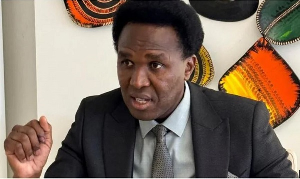Red flag hangs over ABC ... As GBL, GGL move for merger
The merger between the nation?s two brewery giants, Guinness Ghana Limited (GGL) and Ghana Brewery Limited (GBL), is well on course. But a red flag seemingly hangs over the deal, as the Siaw family, original owners of Tata Brewery, known as Achimota Brewery, has petitioned the Government to release their property to them.A former executive director of Tata Brewery, Mr. Joseph Siaw, representing the Siaw family, is contesting the merger between the two breweries, saying it should not be allowed to take place as it involves their property in question.
But GBL says the brewery was advertised internationally and Ghana Brewery through its parent company, Heineken International, bought the business and paid the Ghana Government for it.
?If the Siaw family has a problem it should be directed at the Government of Ghana and not the company,? GBL Corporate Affairs Manager, Major (Rtd) Albert Don-Chebe, told The Chronicle on Monday, last week.
However, the Siaw family has rejected GBL?s claim, arguing that there was no international bidding or tender for the purchase of the brewery. They said what Heineken, as GBL, and her collaborators should know is that they knew very well that there was a contention and controversy over the brewery and yet they went in for it.
The Siaws said GBL and Co should be considered as buyers of stolen property, which renders them as liable as the seller Siaw further stated that they do not believe that any genuine payment was made to the Government.
Tata Brewery, inaugurated on January 30, 1973 by late I. K. Acheampong, was confiscated by the Government in 1979 and later sold to Heineken International BV, who changed its name to GBL, in 1997.
On December 18, 2003, the Boards of GBL and GGL announced that they had entered into discussions with a view to merging the operations of the two companies (the proposed transaction) with the consent of Diageo Plc and Heineken.
But just before the news of the merger could go down, the Siaws fired a petition, strongly opposing the merger.
The family spokesman, Mr. Joseph Siaw, who had in public statements appealed to the Government to release his family property unconditionally, said, ?They were wrongfully acquired by Heineken International BV.?
Siaw said the family has received alarming information that the whole merger issue is a charade to forestall the eventual release of their family property.
He went on further to accuse GBL of cannibalizing the brewery by removing the original equipment, which is priceless in the brewery industry.
For instance, he alleged that a secondhand pasteurizer was brought from war-torn Sierra Leone recently to replace the original one.
?They are bringing in old equipment to replace it with the new ones we left at the brewery,? Siaw asserted.
However, Maj. Don-Chebe, said as owners of the facility, GBL had the right to do whatever it intends with the property.
?I don?t know how much was involved in the purchase of the company but I know it was internationally advertised, five international brewing companies bided for it and one of them won,? Major Don-Chebe said.
?The point I am trying to make,? Major Don-Chebe, went on, ?is that, this is a legitimately purchased business. There are no other owners besides those sitting here. So they have every right to deal with the business in consonance with the laws of the country as they are. So there is no law broken here.?
He denied that a pasteurizer machine had been brought down from Sierra Leone.
However, he admitted that indeed most of the equipment installed in 1972 and 1978 had been removed, but this was in the interest of the company to expand its production.
?We are working on a lot of things, this brewery, most of the equipment at this brewery are outmolded and outdated, the capacity is even low, so what we are doing now is that, we do most of our brewing in Kumasi, and transfer the beer to Achimota to bottle because the brew house in Achimota is so small that it cannot deliver the volume that we require in Achimota.
?For that reason we need to invest in the brew house, by putting in new brew machines to be enable to deliver the capacity that we want.
?So how can somebody say that there is equipment that we are not using or have sold outside?? Major Don-Chebe quipped.
But Mr. Siaw maintained that the brewery had the largest brew house on the continent and that Maj. Don-Chebe should refrain from saying things he does not know.
The capacity of the brewery at the time of the seizure, according to Siaw, was 2.5 million with the expansion and that the original capacity of the company at inception was 250,000-hector liter.
Maj. Don-Chebe confirmed that the current capacity is at 250,000-hector liter, and said there are plans to raise it to 750,000-hector liter. This, he added, necessitated the replacement of most of the equipment at the brewery.
However, Siaw maintained that the pasteurizers were designed in a way to have a longer life span and he believes that they were actually taken outside the country and pointed out that such acts were not helping the nation.
The Brewery Project and OPI Engineer, Joe Ampadu, also told The Chronicle that most of the equipment Mr. Siaw is referring to are unable to cope with modern technology and are of no use in the brewery industry anymore.
This reporter was taken to a room identified as the storage room, which used to have about 40 or so tankers but has now been replaced with pipes.
But Siaw again argued that brewery equipment are not mobile phones, which keep changing by the months, if not weeks. He said Heinekens itself has machines in their original brewery in Holland, which dates back as far as the mid 20th century, let lone machines installed in 1978/79.
Siaw therefore added, ?They should not throw dust into the public eyes.?
On the replacement of the 40 tanks, Siaw argued, ?You can never replace tanks with pipes, the pipes they show you are the pipes that served the tank farm.?
?Where are the control units of the tank farm,? Siaw quipped.
He maintained that the tanks were 42 verticals and 36 horizontals and not 40, as stated by the Corporate Affairs Manager.
He added that they were cold room storage tanks, which form the tank farm.
Some old tanks, identified as brew house, were shown to this reporter at the back of the brewery.
According to the Corporate Affairs Manager, they were of no used to the factory any more and they were removed to make room. The space created is now being used as a warehouse to store malt.
But Siaw said the issue is not about the tanks lying outside but the ones that had been sold outside the country.



















